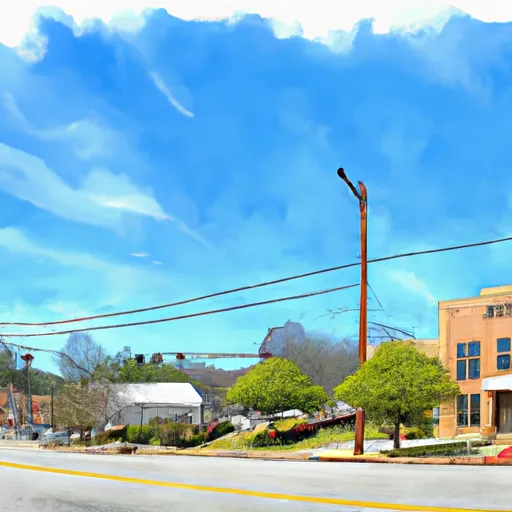-
 Snoflo Premium
Snoflo Premium
Get unlimited access to all our content
With no Ad interruptions! - Start Your Free Trial Login with existing account
Reynolds
Eden Index
Climate
8.2
•
Recreation
2.7
•
Community
0.5
•
Safeguard
4.3/10

Reynolds, Georgia is a small town located in Taylor County, in the central part of the state. The town experiences a humid subtropical climate, characterized by hot, humid summers and mild winters. Summers are typically long, with temperatures frequently reaching the 90s°F (32°C), while winters are relatively mild, with average temperatures in the 50s°F (10°C). Rainfall is evenly distributed throughout the year, with the wettest months being March and July.
Reynolds is situated near several water bodies, including the Flint River and several creeks. These hydrology constituents offer opportunities for various outdoor activities. Fishing enthusiasts can enjoy angling for a variety of freshwater fish species in the area's rivers and creeks. The Flint River is particularly known for its abundant catfish, bass, and panfish populations. Boating and kayaking are popular activities, allowing visitors to explore the scenic waterways and observe the surrounding wildlife.
For those seeking land-based outdoor recreation, Reynolds and its surrounding areas provide ample opportunities for hiking, camping, and wildlife watching. Nearby parks and nature reserves offer well-maintained trails and facilities for visitors to enjoy the natural beauty of the region. With its favorable climate and diverse hydrology, Reynolds, Georgia offers nature enthusiasts a range of outdoor activities to enjoy year-round.
What is the Eden Index?
The Snoflo Eden Index serves as a comprehensive rating system for regions, evaluating their desirability through a holistic assessment of climate health, outdoor recreation opportunities, and natural disaster risk, acknowledging the profound impact of these factors on livability and well-being.
Climate Health Indicator (CHI): 8.2
Reynolds receives approximately
1186mm of rain per year,
with humidity levels near 84%
and air temperatures averaging around
18°C.
Reynolds has a plant hardyness factor of
8, meaning
plants and agriculture in this region tend to thrive here all year round.
By considering the ideal temperature range, reliable water supplies, clean air, and stable seasonal rain or snowpacks, the Climate Health Indicator (CHI) underscores the significance of a healthy climate as the foundation for quality living.
A healthy climate is paramount for ensuring a high quality of life and livability in a region, fostering both physical well-being and environmental harmony. This can be characterized by ideal temperatures, reliable access to water supplies, clean air, and consistent seasonal rain or snowpacks.
Weather Forecast
Streamflow Conditions
Apalachicola
Area Rivers
Apalachicola
Snowpack Depths
Apalachicola
Reservoir Storage Capacity
Apalachicola
Groundwater Levels
Recreational Opportunity Index (ROI): 2.7
The Recreational Opportunity Index (ROI) recognizes the value of outdoor recreational options, such as parks, hiking trails, camping sites, and fishing spots, while acknowledging that climate plays a pivotal role in ensuring the comfort and consistency of these experiences.
Access to outdoor recreational opportunities, encompassing activities such as parks, hiking, camping, and fishing, is crucial for overall well-being, and the climate plays a pivotal role in enabling and enhancing these experiences, ensuring that individuals can engage in nature-based activities comfortably and consistently.
Camping Areas
| Campground | Campsites | Reservations | Toilets | Showers | Elevation |
|---|---|---|---|---|---|
| Whitewater Creek County Park | 48 | 293 ft | |||
| Stone Mountain Park Campground | 430 | 1,558 ft | |||
| Andersonville City Campground | 25 | 350 ft | |||
| Marine Albany RV Military | None | 252 ft | |||
| Indian Springs State Park | None | 503 ft | |||
| High Falls State Park | None | 600 ft | |||
| Parks at Chehaw | 50 | 201 ft | |||
| Sawnee | None | 1,070 ft | |||
| Shoal Creek - Lake Lanier | None | 1,117 ft | |||
| Georgia Veterans State Park | None | 273 ft |
Nearby Ski Areas
Catastrophe Safeguard Index (CSI):
The Catastrophe Safeguard Index (CSI) recognizes that natural disaster risk, encompassing floods, fires, hurricanes, and tornadoes, can drastically affect safety and the overall appeal of an area.
The level of natural disaster risk in a region significantly affects safety and the overall livability, with climate change amplifying these risks by potentially increasing the frequency and intensity of events like floods, fires, hurricanes, and tornadoes, thereby posing substantial challenges to community resilience and well-being.
Community Resilience Indicator (CRI): 0.5
The Community Resilience Indicator (CRI) recognizes that education, healthcare, and socioeconomics are crucial to the well-being of a region. The CRI acknowledges the profound impact of these elements on residents' overall quality of life. By evaluating educational resources, healthcare accessibility, and economic inclusivity, the index captures the essential aspects that contribute to a thriving community, fostering resident satisfaction, equity, and social cohesion.

